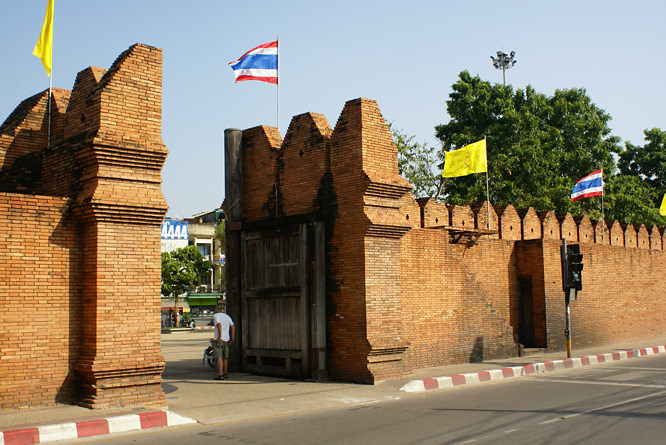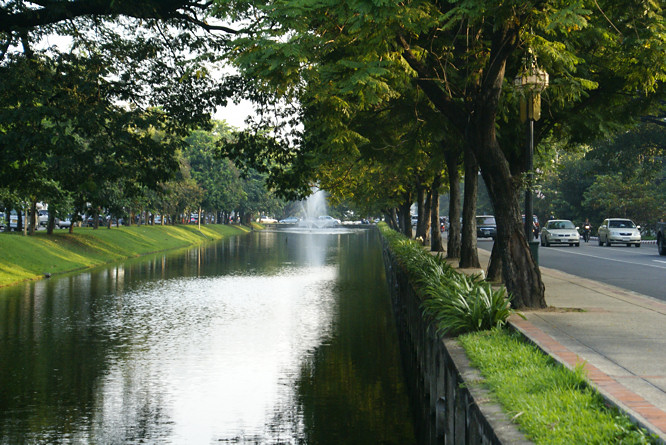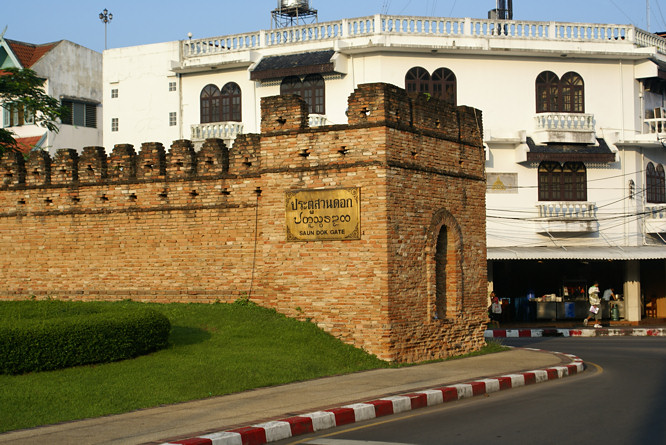Chiang Mai - Ancient Walled City in Northern Thailand
I love the historic ancient walled city of Chiang Mai in Northern Thailand. It is different, such a contrast to the high raised tower blocks of Bangkok, It is a major administration and market town for the region. It is very pretty. You cannot say that about many cities.

The old town of Chiang Mai was protected by a long thick brick built city wall. Amazingly there are a number of sections of the wall still standing along with the old Chiang Mai city gates.
Outside the city wall is the wide defensive moat. This is now tree lined and the moat edges are covered in well kept lush green grass lawns. Walking along the moat admiring the view and walls is a pleasant way to spend a few hours. The trees provide some relief from the hot sun. When you need some refreshment you will find there are lots of street side cafes and bars with tables and chairs outside under parasols. It is very civilized. This cafe culture is not found in Bangkok. Chaing Mai successfully blends its traditional natural Thai charm and old culture with modernization.
Chiang Mai is surrounded by green lush jungle covered mountains. It is a beautiful place with warm hospitable people. Chiang Mai is also predominantly a religious destination with over 1,100 Buddhist Temples and monasteries. When walking around the old town section of Chiang Mai it seems that you cannot walk more than 500 yards without running into a temple.

There are lots of reasons to include Chiang Mai in your holiday itinerary even if it is only for a two day break from Bangkok's madness. There are many things to see and do. My main reason was to go on a days course at the Elephant Nature Park where you get up close to elephants at the orphanage. You feed them, help with their care and take them down to the river and bath them. It is a once in a life time experience set in the middle of the jungle.
The old city of Chiang Mai has narrow lanes surrounded by walled gardens, palm trees, interesting shop fronts and market stalls. Take plenty of water when exploring Chiang Mai. The heat can quickly lead to serious dehydration and exhaustion. Take it easy and drink lots of water. Most temples have a toilet and you can always pop into a hotel or cafe to use the facilities. Bottled water is very cheap. Even the local Thai's find the mid-day sun hard going. You will see many of them carry parasol's. Use your umbrella. No one is going to laugh at you. They will probably be envious of your shade.

You can quickly become 'templed out'. The thought of seeing one more golden Chedi or one more mirrored great hall can make some people shudder. If that is you then seek out the night markets near the river or go for a river cruise.
The population of Chiang Mai has grown to more than 1.5 million. It is now one of Thailand's largest. To accommodate all these people and the thousands of tourists growth has brought with it problems. There are concerns about the rush-hour traffic and the air pollution it causes. Deforestation and the displacement of local tribal people in nearby hills and valleys has occurred to make way for housing, resorts and roads. Chiang Mai still retains its magical charm. It a city with a rich cultural heritage that offers numerous sights and activities for the visitor.
The defensive city walls of Chiang Mai date back to the city's founding in the 13th century but were rebuilt in the 19th century. You can visit many of the original fortified city gates in the wall. They have been restored and serve as useful reference points to help you find your way around.
To the east of the old city of Chiang Mai, between Tha Pae Gate and the Mae Ping River, you will find the main business and shopping areas as you head towards the river. Go to Chang Klan Road as it is home to the popular Chiang Mai Night Bazaar. Here you can find a variety of crafts and other local products. They are offered on sale on street stalls as well as in brick and glass shops. Remember to haggle to get the best price.
You will find banks and currency exchange bureaus. There are a number of restaurants and hotels in the area. We felt very safe walking around the stalls. Thailand's vice industry was not very visible. It is okay to walk around with your children.
East of Chang Klan Road, at the corner of Nawarat Bridge along the Mae Ping River, is the Municipal Tourist Information Center . A little further up river are a major post office and the Warorot Market which is a bustling market selling a diversity of northern food as well as cheap clothing. As you cross Narawat Bridge, Tha Pae Road becomes Charoen Muang Road. From here you can catch a bus south to the historic old city of Lamphun.
The wide, fertile valleys and plains that surround Chiang Mai were able to support a large number of people, This enabled the growth of the feudal kingdom of Lanna which translates to meaning 'Kingdom of a million fields'. Being located at the foot of a mountain range there was a plentiful supply of woos for building. Chiang Mai can be said to owes its existence to the Ping River. The river provided the route along which the military and trading power of Chiang Mai could be extended beyond the wall of mountains that surrounded the valley.
Chiang Mai was the capital of the kingdom of Lanna (the kingdom of a million fields), which enjoyed a golden age throughout the 15th century. During this age the powerful inland kingdom came to control most of what now constitutes northern Thailand, north-western Laos, the eastern Shan states of Burma and Xishuangbanna in southern Yunnan. The religion of the kingdom -Theravada Buddhism - gave rise to a cultural wealth whose influence was to be felt beyond the kingdom's boundaries down the centuries.
The Kingdom of Lanna was caught between the Burmese, and the Siamese Thai of Ayutthaya. Lanna fought several times against the Siamese Thai in the 14th and 15th centuries, draining the strength of the kingdom. Weakened by internal struggles for the throne and by oppression, the city fell to the Burmese forces of King Bayinnaung in 1558. For over two centuries (1558-1774) Chiang Mai was under Burmese control. The fortunes of Chiang Mai declined for the Burmese exploited the city-state for military purposes in their wars with the Siamese Thai of Ayutthaya.
When the locals rebelled they were violently suppressed. Eventually northern Thai forces allied with the Siamese drove the Burmese out, but Chiang Mai was so weak that it was totally abandoned. With Siamese help Chiang Mai was repopulated with local people. The people of the kingdom of Lanna now became allied with the Siamese Thai. Chiang Mai gained strength and prospered. The Kingdom of Siam was renamed Thailand in 1949. Chiang Mai experienced a development boom in the seventies and eighties with the increase in tourism.
Travel books

